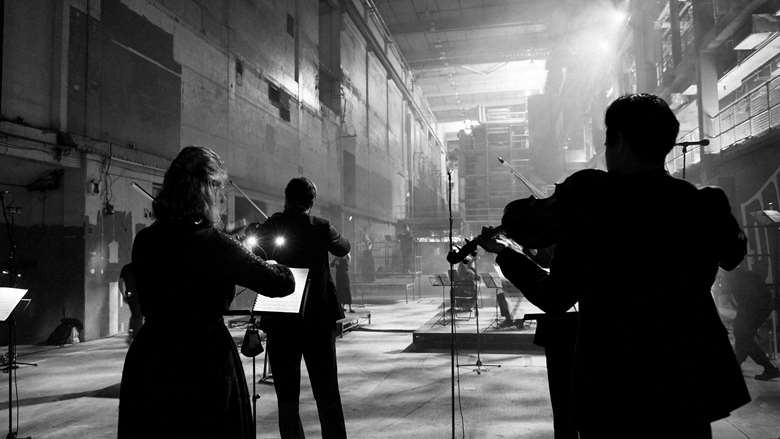d&b Soundscape’s virtual acoustic shell: a mobile home for classical music
Chris Jones
Wednesday, November 10, 2021
Tomorrow night (11 November), a performance of Beethoven’s Symphony No. 7 by Aurora Orchestra puts the technology's considerable power to the test in London's Printworks.

The appreciation of classical music and the need for specific reverberant spaces has been the reason behind the beautiful architecture of some of the world’s most impressive buildings, both modern and historic.
The acoustics inside concert halls such as the Royal Albert Hall, Sydney Opera House or the Boston Symphony Hall are optimised for non-amplified performances, preserving clarity while naturally enhancing the power of the voices and the rich detail of the orchestra, However, this is not the case for the Printworks in London. Once the largest printing press in Western Europe, the venue has since been repurposed into a destination venue for electronic music and so far, classical music has not yet formed part of its repertoire.
This impressive but challenging space has nevertheless been chosen by the award-winning Aurora Orchestra to stage one of their most ambitious projects to date – immersing the audience in a memorised performance of Beethoven’s Symphony No. 7. Not only will the orchestra perform without sheet music, musicians also be widely spaced among the audience around the enormous room.
For John Harte, CEO at Aurora Orchestra, choosing Printworks creates opportunities. He said: ‘Printworks allows us to perform to an audience of up to 1000 people and lets them experience the symphony from amongst the players. This way the musicians are able to connect with the audience on a new, more intimate level.’
An exciting proposition for some, a daunting prospect for others. Leaving the optimal acoustic space behind is often cause for concern, specifically amongst classical music enthusiasts who expect a certain quality of sound. Will the listening experience be as accurate and emotionally direct as it would be when staged in a traditional concert hall?
Global Soundscape specialist Southby Productions provides the solution: a revolutionary, immersive sound technology called d&b Soundscape, created by leading audio technology and solutions provider d&b audiotechnik. The technology creates a transparent, enveloping listening experience that connects the ears to the eyes.
The d&b Soundscape is making waves all around the world. It has been adopted by renowned artists such as Björk, been a trusted solution at the prestigious Ravenna Festival in Italy since 2016 and has lifted well-known performances such as The Nutcracker at the Royal Albert Hall to new heights.
By combining d&b loudspeaker systems with state-of-the-art processing power, object-based mixing and sophisticated room emulation, d&b Soundscape is a toolkit which enables the creation of an unparalleled listening experience for the audience – natural, harmonious, enveloping, and emotionally engaging.
Soundscape was the key to success for this event as it can be applied as a virtual acoustic shell. Utilising a software called En-Space, which recreates acoustic signatures of prestigious classical music venues from around the world and applies these to any stage, indoors or outdoors, without the need for any cumbersome structures or acoustic chambers, Printworks has been acoustically transformed.
The Soundscape En-Space software lets users choose acoustic signatures from some of the most renowned concert halls in the world such as the Mozart Hall in Vienna, the Alghieri Theatre in Ravenna or the Bing Concert Hall in Stanford. These can then be applied to any environment, indoors or outdoors and so concert hall can be conjured up anywhere, enabling classical concerts to be staged in a much wider variety of spaces.
Adam Hockley, technical support at d&b, explained: ‘By recording measurements of the acoustic response of these famous music venues we were able to build a database of reverberation qualities that we can replicate in any given space. By applying the virtual acoustic shell, the musicians benefit from the same sound qualities these spaces would normally generate. This way they are able to get the most out of their performance which in return gives the audience the best possible experience.’
By applying a separate set of speakers and microphones to the stage or performance space, reflections can be reproduced that generate the same sound quality that concert halls are built to achieve and the tonal qualities of each instrument and vocals are supported without distortion.
Southby Productions have been using Soundscape for a number of years and have seen first-hand the transformative power it has on any event. Southby Director Christopher Jones explained why the technology is crucial in making the Aurora Orchestra concert work: ‘Printworks is a former printing press. As you can imagine back then all those presses would have generated a lot of noise. The space has actually been acoustically treated to reduce the immense noise emanating from it. Classical music requires reverberant surfaces for the sound to bounce off from. By using Soundscape, we can create a virtual acoustic shell, effectively modelling an artificial ceiling and walls from which the sounds of the orchestra can be reflected from. The result is a rich amplified sound that orchestras, conductors and audiences fall in love with.’
A memorised symphony, a former printing press, a mobile audience and an invisible acoustic shell – this event has all the hallmarks of an exciting and memorable musical spectacle that is sure to cause a stir.
Chris Jones is Director of Southby Productions.
Aurora Orchestra’s performances of Inside Beethoven at Printworks London will take place at 6pm and 9pm on Thursday 11 November. You can find more information about this event on London Printworks' website.